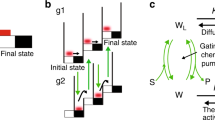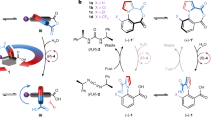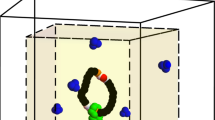Abstract
Information is physical, a realization that has transformed the physics of measurement and communication. However, the flow between information, energy and mechanics in chemical systems remains largely unexplored. Here we analyse a minimalist autonomous chemically driven molecular motor in terms of information thermodynamics, a framework that quantitatively relates information to other thermodynamic parameters. The treatment reveals how directional motion is generated by free energy transfer from chemical to mechanical (conformational and/or co-conformational) processes by ‘energy flow’ and ‘information flow’. It provides a thermodynamic level of understanding of molecular motors that is general, complements previous analyses based on kinetics and has practical implications for machine design. In line with kinetic analysis, we find that power strokes do not affect the directionality of chemically driven machines. However, we find that power strokes can modulate motor velocity, the efficiency of free energy transfer and the number of fuel molecules consumed per cycle. This may help explain the role of such (co-)conformational changes in biomachines and illustrates the interplay between energy and information in chemical systems.

This is a preview of subscription content, access via your institution
Access options
Access Nature and 54 other Nature Portfolio journals
Get Nature+, our best-value online-access subscription
$29.99 / 30 days
cancel any time
Subscribe to this journal
Receive 12 print issues and online access
$259.00 per year
only $21.58 per issue
Buy this article
- Purchase on Springer Link
- Instant access to full article PDF
Prices may be subject to local taxes which are calculated during checkout




Similar content being viewed by others
Data availability
All data needed to reproduce the numerical results are reported in the Supplementary Information.
Code availability
The code that generated the plots is available at the following link: gitlab.com/emanuele.penocchio/infothermorotmot
References
Chatterjee, M. N., Kay, E. R. & Leigh, D. A. Beyond switches: ratcheting a particle energetically uphill with a compartmentalized molecular machine. J. Am. Chem. Soc. 128, 4058–4073 (2006).
Coskun, A., Banaszak, M., Astumian, R. D., Stoddart, J. F. & Grzybowski, B. A. Great expectations: can artificial molecular machines deliver on their promise? Chem. Soc. Rev. 41, 19–30 (2012).
Erbas-Cakmak, S., Leigh, D. A., McTernan, C. T. & Nussbaumer, A. L. Artificial molecular machines. Chem. Rev. 115, 10081–10206 (2015).
Qiu, Y., Feng, Y., Guo, Q.-H., Astumian, R. D. & Stoddart, J. F. Pumps through the ages. Chem 6, 1952–1977 (2020).
Aprahamian, I. The future of molecular machines. ACS Cent. Sci. 6, 347–358 (2020).
Howard, J. Mechanics of Motor Proteins and the Cytoskeleton (Oxford Univ. Press, 2001).
Astumian, R. D., Mukherjee, S. & Warshel, A. The physics and physical chemistry of molecular machines. Chemphyschem 17, 1719–1741 (2016).
Koumura, N., Zijlstra, R. W. J., van Delden, R. A., Harada, N. & Feringa, B. L. Light-driven monodirectional molecular rotor. Nature 401, 152–155 (1999).
Serreli, V., Lee, C.-F., Kay, E. R. & Leigh, D. A. A molecular information ratchet. Nature 445, 523–527 (2007).
Cheng, C. et al. An artificial molecular pump. Nat. Nanotechnol. 10, 547–553 (2015).
Ragazzon, G., Baroncini, M., Silvi, S., Venturi, M. & Credi, A. Light-powered autonomous and directional molecular motion of a dissipative self-assembling system. Nat. Nanotechnol. 10, 70–75 (2015).
Erbas-Cakmak, S. et al. Rotary and linear molecular motors driven by pulses of a chemical fuel. Science 358, 340–343 (2017).
Amano, S., Fielden, S. D. P. & Leigh, D. A. A catalysis-driven artificial molecular pump. Nature 594, 529–534 (2021).
Wilson, M. R. et al. An autonomous chemically fuelled small-molecule motor. Nature 534, 235–240 (2016).
Astumian, R. D. How molecular motors work—insights from the molecular machinist’s toolbox: the Nobel Prize in Chemistry 2016. Chem. Sci. 8, 840–845 (2017).
Astumian, R. D. Kinetic asymmetry allows macromolecular catalysts to drive an information ratchet. Nat. Commun. 10, 3837 (2019).
Ragazzon, G. & Prins, L. J. Energy consumption in chemical fuel-driven self-assembly. Nat. Nanotechnol. 13, 882–889 (2018).
Esposito, M. Open questions on nonequilibrium thermodynamics of chemical reaction networks. Commun. Chem. 3, 107 (2020).
Kelly, T. R., De Silva, H. & Silva, R. A. Unidirectional rotary motion in a molecular system. Nature 401, 150–152 (1999).
Mock, W. L. & Ochwat, K. J. Theory and example of a small-molecule motor. J. Phys. Org. Chem. 16, 175–182 (2003).
Fletcher, S. P., Dumur, F., Pollard, M. M. & Feringa, B. L. A reversible, unidirectional molecular rotary motor driven by chemical energy. Science 310, 80–82 (2005).
Collins, B. S. L., Kistemaker, J. C. M., Otten, E. & Feringa, B. L. A chemically powered unidirectional rotary molecular motor based on a palladium redox cycle. Nat. Chem. 8, 860–866 (2016).
Zhang, Y. et al. A chemically driven rotary molecular motor based on reversible lactone formation with perfect unidirectionality. Chem 6, 2420–2429 (2020).
Borsley, S., Leigh, D. A. & Roberts, B. M. W. A doubly kinetically-gated information ratchet autonomously driven by carbodiimide hydration. J. Am. Chem. Soc. 143, 4414–4420 (2021).
Seifert, U. Stochastic thermodynamics, fluctuation theorems and molecular machines. Rep. Prog. Phys. 75, 126001 (2012).
Parrondo, J. M. R. & de Cisneros, B. J. Energetics of Brownian motors: a review. Appl. Phys. A 75, 179–191 (2002).
Esposito, M., Lindenberg, K. & Van den Broeck, C. Universality of efficiency at maximum power. Phys. Rev. Lett. 102, 130602 (2009).
Benenti, G., Casati, G., Saito, K. & Whitney, R. S. Fundamental aspects of steady-state conversion of heat to work at the nanoscale. Phys. Rep. 694, 1–124 (2017).
Jarzynski, C. Equalities and inequalities: irreversibility and the second law of thermodynamics at the nanoscale. Annu. Rev. Condens. Matter Phys. 2, 329–351 (2011).
Peliti, L. & Pigolotti, S. Stochastic Thermodynamics: An Introduction (Princeton Univ. Press, 2021).
Andrieux, D. & Gaspard, P. Fluctuation theorems and the nonequilibrium thermodynamics of molecular motors. Phys. Rev. E 74, 011906 (2006).
Lipowsky, R. & Liepelt, S. Chemomechanical coupling of molecular motors: thermodynamics, network representations, and balance conditions. J. Stat. Phys. 130, 39–67 (2008).
Toyabe, S. et al. Nonequilibrium energetics of a single F1-ATPase molecule. Phys. Rev. Lett. 104, 198103 (2010).
Ariga, T., Tomishige, M. & Mizuno, D. Nonequilibrium energetics of molecular motor kinesin. Phys. Rev. Lett. 121, 218101 (2018).
Brown, A. I. & Sivak, D. A. Theory of nonequilibrium free energy transduction by molecular machines. Chem. Rev. 120, 434–459 (2020).
Ciliberto, S. Experiments in stochastic thermodynamics: short history and perspectives. Phys. Rev. X 7, 021051 (2017).
McGrath, T., Jones, N. S., ten Wolde, P. R. & Ouldridge, T. E. Biochemical machines for the interconversion of mutual information and work. Phys. Rev. Lett. 118, 028101 (2017).
Cover, T. M. & Thomas, J. A. Elements of Information Theory (Wiley, 2012).
Parrondo, J. M. R., Horowitz, J. M. & Sagawa, T. Thermodynamics of information. Nat. Phys. 11, 131–139 (2015).
Horowitz, J. M. & Esposito, M. Thermodynamics with continuous information flow. Phys. Rev. X 4, 031015 (2014).
Leff, H. S. & Rex, A. F. (eds) Maxwell’s Demon: Entropy, Information, Computing (Princeton Univ. Press, 1990).
Rao, R. & Esposito, M. Nonequilibrium thermodynamics of chemical reaction networks: wisdom from stochastic thermodynamics. Phys. Rev. X 6, 041064 (2016).
Penocchio, E., Rao, R. & Esposito, M. Thermodynamic efficiency in dissipative chemistry. Nat. Commun. 10, 3865 (2019).
Wagoner, J. A. & Dill, K. A. Mechanisms for achieving high speed and efficiency in biomolecular machines. Proc. Natl Acad. Sci. USA 116, 5902–5907 (2019).
Howard, J. Protein power strokes. Curr. Biol. 16, R517–R519 (2006).
Hwang, W. & Karplus, M. Structural basis for power stroke vs. Brownian ratchet mechanisms of motor proteins. Proc. Natl Acad. Sci. USA 116, 19777–19785 (2019).
Astumian, R. D. Irrelevance of the power stroke for the directionality, stopping force, and optimal efficiency of chemically driven molecular machines. Biophys. J. 108, 291–303 (2015).
Pezzato, C., Cheng, C., Stoddart, J. F. & Astumian, R. D. Mastering the non-equilibrium assembly and operation of molecular machines. Chem. Soc. Rev. 46, 5491–5507 (2017).
Das, K., Gabrielli, L. & Prins, L. J. Chemically-fueled self-assembly in biology and chemistry. Angew. Chem. Int. Ed. 60, 20120–20143 (2021).
Albaugh, A. & Gingrich, T. R. Simulating a chemically-fueled molecular motor with nonequilibrium molecular dynamics. Preprint at https://doi.org/10.48550/arXiv.2102.06298 (2021).
Horowitz, J. M., Sagawa, T. & Parrondo, J. M. R. Imitating chemical motors with optimal information motors. Phys. Rev. Lett. 111, 010602 (2013).
Fyfe, M. C. T. et al. Anion-assisted self-assembly. Angew. Chem. Int. Ed. 36, 2068–2070 (1997).
Astumian, R. D. Design principles for Brownian molecular machines: how to swim in molasses and walk in a hurricane. Phys. Chem. Chem. Phys. 9, 5067–5083 (2007).
Hartich, D., Barato, A. C. & Seifert, U. Stochastic thermodynamics of bipartite systems: transfer entropy inequalities and a Maxwell’s demon interpretation. J. Stat. Mech. Theory Exp. 2014, P02016 (2014).
Kondepudi, D. K. & Prigogine, I. Modern Thermodynamics: From Heat Engines to Dissipative Structures (Wiley, 2015).
Astumian, R. & Bier, M. Mechanochemical coupling of the motion of molecular motors to ATP hydrolysis. Biophys. J. 70, 637–653 (1996).
Kinosita, K. Jr., Yasuda, R., Noji, H. & Adachi, K. A rotary molecular motor that can work at near 100% efficiency. Philos. Trans. R. Soc. Lond. B 355, 473–489 (2000).
Watt, I. N., Montgomery, M. G., Runswick, M. J., Leslie, A. G. W. & Walker, J. E. Bioenergetic cost of making an adenosine triphosphate molecule in animal mitochondria. Proc. Natl Acad. Sci. USA 107, 16823–16827 (2010).
Petersen, J., Förster, K., Turina, P. & Gräber, P. Comparison of the H+/ATP ratios of the H+-ATP synthases from yeast and from chloroplast. Proc. Natl Acad. Sci. USA 109, 11150–11155 (2012).
Hill, T. L. Free Energy Transduction in Biology (Academic Press, 1977).
Alvarez-Pérez, M., Goldup, S. M., Leigh, D. A. & Slawin, A. M. Z. A chemically-driven molecular information ratchet. J. Am. Chem. Soc. 130, 1836–1838 (2008).
Carlone, A., Goldup, S. M., Lebrasseur, N., Leigh, D. A. & Wilson, A. A three-compartment chemically-driven molecular information ratchet. J. Am. Chem. Soc. 134, 8321–8323 (2012).
Lussis, P. et al. A single synthetic small molecule that generates force against a load. Nat. Nanotechnol. 6, 553–557 (2011).
Amano, S., Borsley, S., Leigh, D. A. & Sun, Z. Chemical engines: driving systems away from equilibrium through catalyst reaction cycles. Nat. Nanotechnol. 16, 1057–1067 (2021).
Kay, E. R., Leigh, D. A. & Zerbetto, F. Synthetic molecular motors and mechanical machines. Angew. Chem. Int. Ed. 46, 72–191 (2007).
Blackmond, D. G. ‘If pigs could fly’ chemistry: a tutorial on the principle of microscopic reversibility. Angew. Chem. Int. Ed. 48, 2648–2654 (2009).
Katz, S., Lebowitz, J. L. & Spohn, H. Phase transitions in stationary nonequilibrium states of model lattice systems. Phys. Rev. B 28, 1655–1658 (1983).
Esposito, M. Stochastic thermodynamics under coarse graining. Phys. Rev. E 85, 041125 (2012).
Maes, C. Local detailed balance. SciPost Phys. Lect. Notes 32, https://doi.org/10.48550/arXiv.2102.06298 (2021).
Acknowledgements
We acknowledge support from the European Research Council (ERC Consolidator grant no. 681456 to M.E. and funding to E.P.; ERC Advanced grant no. 786630 to D.A.L.), the FQXi Foundation, project ‘Information as a fuel in colloids and superconducting quantum circuits’ (grant no. FQXi-IAF19-05 to M.E.), the Engineering and Physical Sciences Research Council (EPSRC; grant no. EP/P027067/1 to D.A.L.), the Deutsche Forschungsgemeinschaft (a postdoctoral fellowship to E.K.) and the University of Manchester and EPSRC for PhD studentships to S.A. and B.M.W.R. D.A.L. is a Royal Society Research Professor. We thank R. D. Astumian for valuable discussions regarding the science in this study as well as robust debate regarding the use of the term ‘local detailed balance’ within the stochastic thermodynamics community.
Author information
Authors and Affiliations
Contributions
S.A., B.M.W.R. and E.K. proposed the collaboration. E.P. developed the theoretical model. S.A., B.M.W.R., E.P. and E.K. carried out the theoretical analysis and simulations. D.A.L. and M.E. directed the research. All authors contributed to the analysis of the results and the writing of the manuscript.
Corresponding authors
Ethics declarations
Competing interests
The authors declare no competing interests.
Peer review
Peer review information
Nature Chemistry thanks the anonymous reviewers for their contribution to the peer review of this work.
Additional information
Publisher’s note Springer Nature remains neutral with regard to jurisdictional claims in published maps and institutional affiliations.
Supplementary information
Supplementary Information
Supplementary Sections I–VI, Figs. 1–6, equations 1–70 and Table I.
Rights and permissions
About this article
Cite this article
Amano, S., Esposito, M., Kreidt, E. et al. Insights from an information thermodynamics analysis of a synthetic molecular motor. Nat. Chem. 14, 530–537 (2022). https://doi.org/10.1038/s41557-022-00899-z
Received:
Accepted:
Published:
Issue Date:
DOI: https://doi.org/10.1038/s41557-022-00899-z



